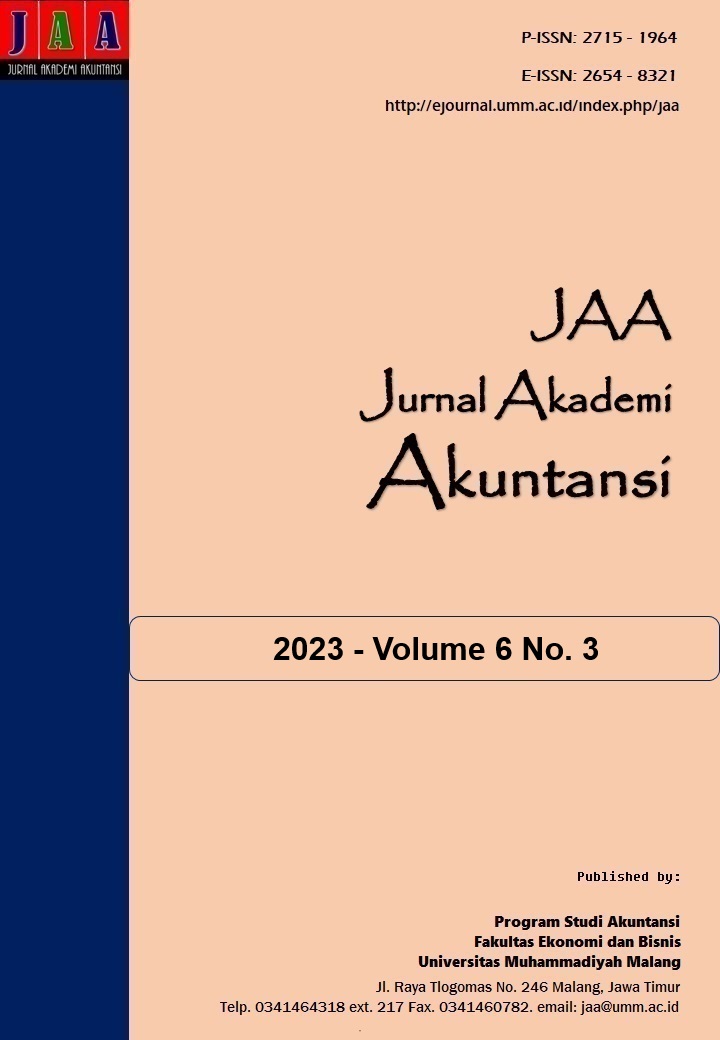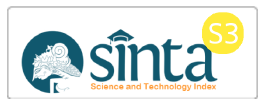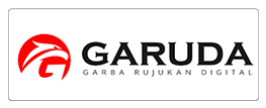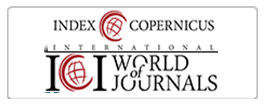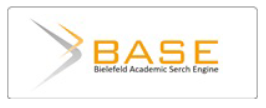Praktek Income Smoothing Ditinjau dari Cash Holding, Bonus Plan, Kepemilikan Institusional dan Profitabilitas
DOI:
https://doi.org/10.22219/jaa.v6i3.28155Keywords:
Bonus Plan, Cash Holding, Income Smoothing, Institutional Ownership, ProfitabilityAbstract
Purpose: This study aims to examine the effect of cash holding, bonus plans, institutional ownership, and profitability on income smoothing in financial sector companies listed on the Indonesia Stock Exchange.
Methodology/approach: The research data is sourced from the Annual Report and Share Price Information of Finacial Companies Listed on the IDX (Indonesian Stock Exchange) 2017-2021. The analytical method uses logistic regression by SPSS 26.
Findings: The results show that cash holding and bonus plan have no significant effect on income smoothing. Meanwhile, institutional ownership and profitability have signuficant effect on income smoothing
Practical and Theoretical contribution/Originality: The implication of this research is expected to help investors and shareholders to understand the factors that can maximize management behavior to do income smoothing on financial statement. In addition, potential investors are expected to be able to use the findings of this study to help them assess the condition of the company before making investment decisions. Novelty of this research is focusing on the financial sector as a sample whereas previous research only focused on the non-financial sector.
Research Limitation: Future studies may be useful to use other variables to income smoothing examined to provide a newly additional finding.
Downloads
References
Adeliana, M. A., & Suryanawa, I. K. (2012). Pengaruh Leverage, Bonus Plan, Ukuran Perusahaan, dan Profitabilitas pada Praktik Perataan Laba. E-Jurnal Akuntansi Universitas Udayana, 26(1), 58–84. https://doi.org/10.24843/EJA.2019.v26.i01.p03
Adiani, S. N., & Astika, I. B. P. (2019). Pengaruh Struktur Kepemilikan dan Ukuran Perusahaan Pada Praktik Perataan Laba Fakultas Ekonomi dan Bisnis Universitas Udayana ( Unud ), Bali , Indonesia PENDAHULUAN Perkembangan pasar modal semakin pesat di Indonesia . Perusahaan menerbitkan saham untuk. 27, 984–1012. https://doi.org/10.24843/EJA.2019.v27.i02.p06
Adiwidjaja, D. E., & Tundjung, H. (2019). Pengaruh Cash Holding, Firm Size, Profitability, Dan Financial Leverage Terhadap Income Smoothing. Jurnal Paradigma Akuntansi, 1(3), 712–720.
Alexander, N. (2019). The effect of ownership structure, cash holding and tax avoidance on income smoothing. Nico Alexander, 128–134.
Alsyouf, I. (2007). The role of maintenance in improving companies’ productivity and profitability. International Journal of Production Economics, 105(1), 70–78. https://doi.org/10.1016/j.ijpe.2004.06.057
Anwar, A., & Gunawan, G. (2020). Can Cash Holding, Bonus Plan, Company Size and Profitability Affect Income Smoothing Practices? Point of View Research Accounting and Auditing, 1(3), 49–56. https://doi.org/10.47090/povraa.v1i3.35
Arieza, U. (2019). Menyoal Laba BUMN yang mendadak Kinclong. https://www.cnnindonesia.com/ekonomi/20190531144248-92-400048/menyoal-laba-bumn-yang-mendadak-kinclong
Ashari, N., Koh, H. C., Tan, S. L., & Wong, W. H. (1994). Factors Affecting Income Smoothing Among Listed Companies in Singapore. Accounting and Business Research, 24(96), 291–301. https://doi.org/10.1080/00014788.1994.9729488
Azzahra, Q. (2021). Window dressing: Tradisi poles laporan keuangan lebih cantik. https://www.alinea.id/bisnis/window-dressing-tradisi-poles-laporan-keuangan-lebih-cantik-b2cDF97WU
Babu, D. G. S. (2018). Role of financial system in economic development of a country. International Journal of Multidisciplinary Research and Development, 5(8), 100–107.
Cline, B. N., Walkling, R. A., & Yore, A. S. (2017). Profitabilitas, Ukuran Perusahaan, Dan Nilai Perusahaan Terhadap Praktik Perataan Laba. Journal of Financial Economics, 0(2), 1–27. https://doi.org/https://doi.org/10.23969/jrak.v9i2.581
Dalimunte, I. P., & Prananti, W. (2019). Pengaruh Cash Holding, Profitabilitas, Dan Financial Leverage Terhadap Income Smoothing Pada Perusahaan Manufaktur. EkoPreneur, 1(1), 13. https://doi.org/10.32493/ekop.v1i1.3666
Devina, R., Ati, S., & Dwi, H. (2021). Pengaruh Profitabilitas, Financial Leverage, Kepemilikan Publik, dan Ukuran Perusahaan terhadap Perataan Laba. Jurnal Akuntansi, Perpajakan Dan Auditing, 2(3), 579–599. https://doi.org/10.21009/japa.0203.06
Dewi, P. P., & Do Rego, C. M. (2018). Kompensasi bonus, kepemilikan keluarga dan manajemen laba. Jurnal Ilmiah Akuntansi Dan Bisnis, 3(1), 71–81.
Diah, P., & Nyoman, G. (2018). Pengaruh Financial Leverage, Cash Holding, Dan Roa Pada Income Smoothing Di Bursa Efek Indonesia. E-Jurnal Akuntansi, 22, 1936. https://doi.org/10.24843/EJA.2018.v22.i03.p11
Forentina, M., & Hastuti, R. T. (2022). Pengaruh Profitability Dan Institutional Ownership Terhadap Income Smoothing Dengan Moderasi Firm Size. Jurnal Ekonomi, 27(03), 242–263. https://doi.org/10.24912/je.v27i03.875
Ghozali, I. (2021). Aplikasi Analisis Multivariete Dengan Program IBM SPSS 25 (Edisi 9). In Penelitian. https://doi.org/10.1021/ol7029646
Haniftian, R. A., & Dillak, V. J. (2020). Pengaruh Profitabilitas, Cash Holding, Dan Nilai Perusahaan Terhadap Perataan Laba. Jae (Jurnal Akuntansi Dan Ekonomi), 5(1), 88–98. https://doi.org/10.29407/jae.v5i1.14163
Jaya, F., & Dillak, J. (2019). Income Smoothing: Ukuran Perusahaan, Leverage, Profitabilitas, dan Umur Perusahaan (Studi Pada Perusahaan yang Termasuk Dalam Indeks Kompas100 Tahun 2013 sampai dengan 2017). Pekbis Jurnal, 11(2), 85–95.
Jogiyanto, H. (2013). Teori Portofolio dan Analisis Investasi Edisi Kesembilan.pdf.
Jung, B., Lee, D., Shin, I., & Yuen, C. Y. D. (2020). Foreign equity ownership and income smoothing. Journal of International Accounting Research, 19(2), 141–162.
Kayo, E. S. (2020). Klasifikasi Sektor Keuangan. https://www.sahamok.net/emiten/sektor-keuangan/
Khadijeh, K. (2013). Income Smoothing Practices: An Empirical Investigation Of Listed Firms In Tehran Stock Exchange (Tse). Indian Streams Research Journal, 3(10), 4–11. https://doi.org/10.17509/jpak.v8i2.24588
Koh, P. S. (2005). Institutional Ownership and Income Smoothing: Australian Evidence. Accounting Research Journal, 18(2), 93–110. https://doi.org/10.1108/10309610580000678
Lestari, D., & Aprilia, D. (2020). Apakah Financial Leverage dan Kepemilikan Institusional Mempengaruhi Tindakan Perataan Laba? Jurnal Pendidikan Akuntansi & Keuangan, 8(2), 168–179. https://doi.org/10.17509/jpak.v8i2.24588
Maotama, N. S., & Astika, I. B. P. (2020). Pengaruh profitabilitas, ukuran perusahaan, dan kepemilikan manajerial terhadap praktik perataan laba (Income Smoothing). E-Jurnal Akuntansi, 30(7), 1767.
Miftah, D., & Murwaningsari, E. (2018). Bonus Plan and Income Smoothing on the Selection of Accounting Policy and Corporate Governance Determination Manufacturing Companies Listed on the Indonesian Stock Exchange Evidance. An International Peer-Reviewed Journal, 41, 1–11.
Natalie, N., & Astika, I. B. P. (2016). Pengaruh Cash Holding, Bonus Plan, Reputasi Auditor, Profitabilitas dan Leverage pada Income Smoothing. E-Jurnal Akuntansi Universitas Udayana, 15(2), 943–972.
Nathania, C., & Prima, S. (2022). Faktor-Faktor Yang Memengaruhi Income Smoothing Dengan Mediasi Effective Tax Rates. Jurnal Paradigma Akuntansi, 4(2), 677–777. https://doi.org/10.24912/jpa.v4i2.19569
Ningrum, D. P., Werimon, S., & Simanjuntak, V. (2021). Pengaruh Cash Holding Dan Bonus Plan Terhadap Income Smoothing (Studi Kasus Pada Perusahaan Manufaktur Yang Terdaftar Di Bursa Efek Indonesia Periode 2017-2019). Accounting Research Journal, 1(2), 93–106.
Nirmanggi, I. P., & Muslih, M. (2020). Pengaruh Operating Profit Margin, Cash Holding, Bonus Plan, dan Income Tax terhadap Perataan Laba. Jurnal Ilmiah Akuntansi, 5(1), 25. https://doi.org/10.23887/jia.v5i1.23210
Novita, M. (2015). Pengaruh Konflik Bondholders-Shareholders, Bonus Plan Dan Political Cost Terhadap Konservatisme Akuntansi (Pada Perusahaan Manufaktur Sub-Sektor Industri Konsumsi Terdaftar Di Bursa Efek Indonesia Periode 2012-2015).
Nurani, W., & Dillak, V. J. (2019). Pengaruh profitabilitas, struktur modal, kepemilikan publik dan bonus plan terhadap income smoothing. JASa (Jurnal Akuntansi, Audit Dan Sistem Informasi Akuntansi), 3(1), 154–168.
Oktavinawati, & Herawaty, V. (2022). Pengaruh Cash Holding, Bonus Plan, Dan Profitabilitas Terhadap Income Smoothing Dengan Kualitas Audit Sebagai Variabel Moderasi. Jurnal Ekonomi Trisakti, 2(2), 515–528.
Ozili, P. K. (2019). Bank income smoothing, institutions and corruption. Research in International Business and Finance, 49, 82–99. https://doi.org/10.1016/j.ribaf.2019.02.009
Pradipta, A., & Susanto, Y. K. (2019). Firm Value, Firm Size and Income Smoothing. GATR Journal of Finance and Banking Review, 4(1), 01–07. https://doi.org/10.35609/jfbr.2019.4.1(1)
Pratiwi, N., & Damayanthi, I. (2017). Analisis Perataan Laba Dan Faktor-Faktor Yang Mempengaruhinya. E-Jurnal Akuntansi Universitas Udayana, 20(1), 496–525.
Puji, D., & Tundjung, H. (2022). Faktor-Faktor Yang Mempengaruhi Cash Holding Pada Perusahaan Manufaktur Yang Terdaftar Di BEI. Jurnal Paradigma Akuntansi, 4(2), 629–636.
Putra, M. D. P., Mahaputra, I. N. K. A., & Pasupati, B. (2021). Determinan Faktor Yang Mempengaruhi Praktik Perataan Laba Pada Perusahaan Manufaktur Yang Terdaftar Di Bursa Efek Indonesia. Akbis: Media Riset Akuntansi Dan Bisnis, 5(1), 33. https://doi.org/10.35308/akbis.v5i1.3559
Riyadi, S. (2017). Akuntansi Manajemen. Taman Sidoarjo: Zifataman Publisher.
Roflin, E., Riana, F., Munarsih, E., & Liberty, I. A. (2023). Regresi Logistik Biner dan Multinomial. Penerbit NEM.
Sanjaya, W., & Surjadi, L. (2018). Faktor-faktor yang mempengaruhi income smoothing pada perusahaan manufaktur periode 2014-2016. Jurnal Ekonomi, 23(3), 347–358.
Santoso, E. B., & Salim, S. N. (2023). Pengaruh profitabilitas, financial leverage, dividen, ukuran perusahaan, kepemilikan institusional, dan kelompok usaha terhadap perataan laba studi kasus pada perusahaan non-finansial yang terdaftar di BEI. Conference in Business, Accounting, and Management (CBAM), 1(1), 185–213.
Scott, W. R. (2015). Financial Accounting Theory. Seventh Edition.
Simamora, H. (2015). Manajemen Sumber Daya Manusia.
Sultan, M. (2021). Relationship Between Firm Size and Profitability with Income Smoothing: Evidence from Food and Beverages (F&B) Firms in Jordan. Journal of Asian Finance, 8(6), 789–0796. https://doi.org/10.13106/jafeb.2021.vol8.no6.0789
Suyono, E. (2018). Institutional Ownership, Types of Industry, and Income Smoothing: Empirical Evidence from Indonesia. Journal of Auditing, Finance, and Forensic Accounting, 6(1), 1–12. https://doi.org/10.21107/jaffa.v6i1.4128
Tarigan, M. T., & Utami, N. (2021). Analysis of the Influence of Cash Holding, Profitability, and Stock Price on Income Smoothing. South East Asia Journal of Contemporary Business, Economics and Law, 24(1), 8–14.
Toni, N., MM, C., Simorangkir, E. N., Hebert Kosasih, S. E., & Ak, M. (2021). Praktik perataan laba (Income smoothing) perusahaan: Strategi peningkatan profitabilitas, financial leverage, dan kebijakan dividen bagi perusahaan. Penerbit Adab.
Watts, R. L., & Zimmerman, J. L. (1990). Positive Accounting Theory: A Ten Year Perspective. The Accounting Review, 65(1), 131–156.
Downloads
Published
Issue
Section
License
Copyright (c) 2023 Sari Fadillah, Elvira Luthan

This work is licensed under a Creative Commons Attribution-NonCommercial-ShareAlike 4.0 International License.
Jurnal Akademi Akuntansi is licensed under a Creative Commons Attribution-NonCommercial-ShareAlike 4.0 International License.
Authors who publish with this journal agree to the following terms:
- Authors retain copyright and grant the journal right of first publication with the work simultaneously licensed under a Creative Commons Attribution-NonCommercial-ShareAlike 4.0 International License that allows others to share the work with an acknowledgment of the work's authorship and initial publication in this journal.
- Authors are able to enter into separate, additional contractual arrangements for the non-exclusive distribution of the journal's published version of the work (e.g., post it to an institutional repository or publish it in a book), with an acknowledgment of its initial publication in this journal.
- Authors are permitted and encouraged to post their work online (e.g., in institutional repositories or on their website) prior to and during the submission process, as it can lead to productive exchanges, as well as earlier and greater citation of published work (See The Effect of Open Access).
Jurnal Akademi Akuntansi dilisensikan di bawah lisensi Creative Commons Attribution-NonCommercial-ShareAlike 4.0 International.
Penulis yang menerbitkan artikel di jurnal ini menyetujui ketentuan berikut:
- Penulis mempertahankan hak cipta dan memberikan hak jurnal atas publikasi pertama dengan karya yang secara serentak dilisensikan di bawah Lisensi Pengaitan Creative Commons yang memungkinkan orang lain untuk berbagi karya dengan pengakuan atas karya penulis dan publikasi awal dalam jurnal ini.
- Penulis dapat masuk ke dalam pengaturan kontrak tambahan yang terpisah untuk distribusi non-eksklusif versi karya jurnal yang diterbitkan (misalnya, mempostingnya ke repositori institusional atau mempublikasikannya dalam sebuah buku), dengan pengakuan publikasi awalnya di jurnal ini.
- Penulis diizinkan dan didorong untuk memposting pekerjaan mereka secara online (misalnya, di repositori institusional atau di situs web mereka) sebelum dan selama proses pengajuan, karena dapat mengarah pada pertukaran produktif, serta kutipan pekerjaan sebelumnya dan yang lebih besar (Lihat Pengaruh Akses Terbuka).

